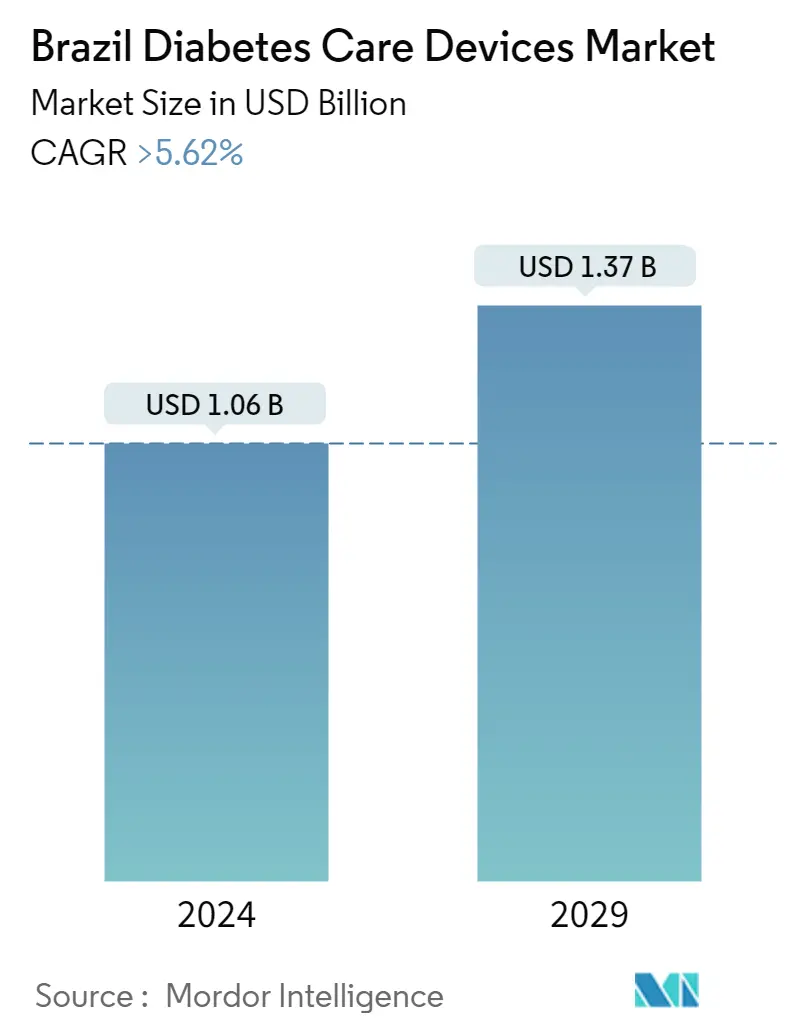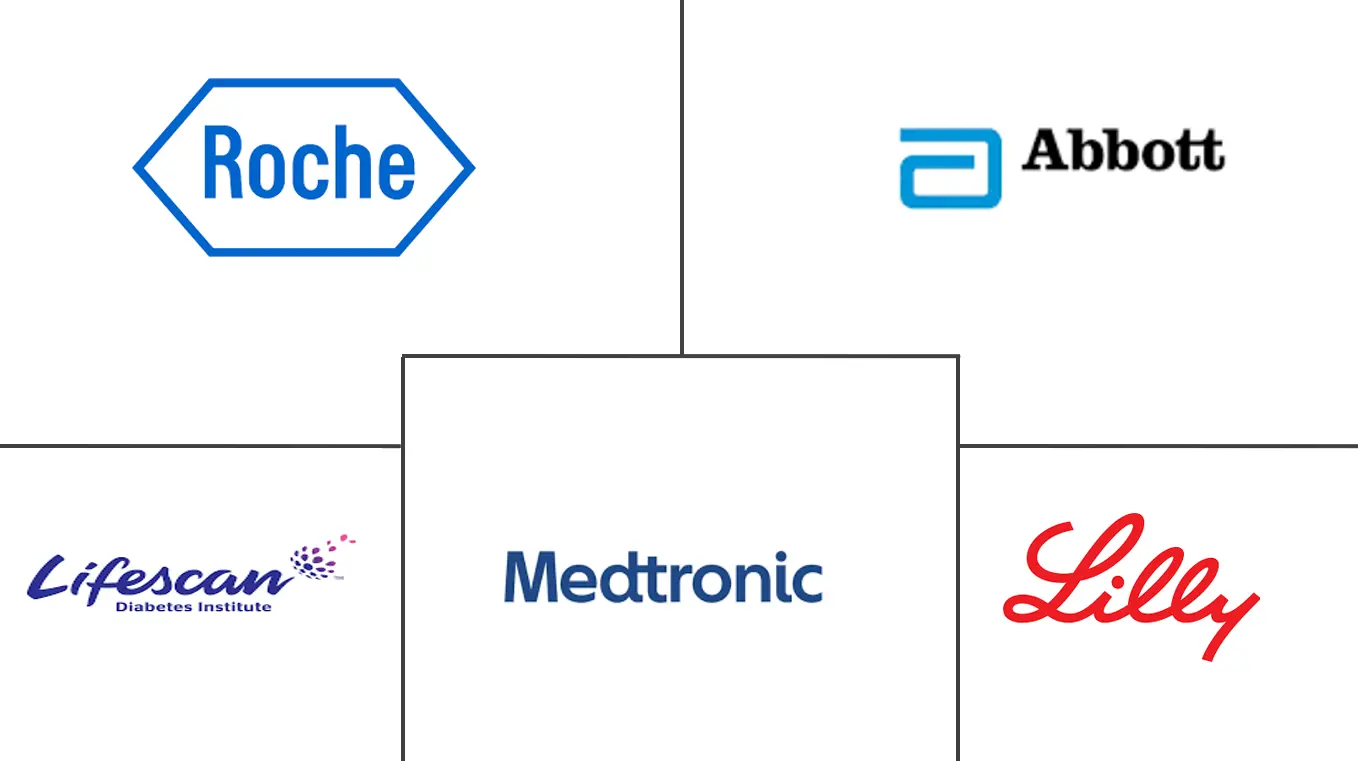Market Size of Brazil Diabetes Care Devices Industry

| Study Period | 2018 - 2029 |
| Base Year For Estimation | 2023 |
| Forecast Data Period | 2024 - 2029 |
| Market Size (2024) | USD 1.06 Billion |
| Market Size (2029) | USD 1.37 Billion |
| CAGR (2024 - 2029) | 5.62 % |
Major Players
*Disclaimer: Major Players sorted in no particular order |
Brazil Diabetes Care Devices Market Analysis
The Brazil Diabetes Care Devices Market size is estimated at USD 1.06 billion in 2024, and is expected to reach USD 1.37 billion by 2029, growing at a CAGR of greater than 5.62% during the forecast period (2024-2029).
The COVID-19 pandemic has had a notable impact on the diabetes care devices market. Diabetes is a chronic condition demanding self-management and care, which involves regular attention to food, physical activity, blood sugar monitoring, and the use of medications. People with chronic diseases such as diabetes mellitus and obesity have a worse prognosis of COVID-19. Diabetic people are twice more likely to have their comorbid conditions worsened, and consequently to die. The healthcare system must be better organized for more severe cases of COVID-19 as studies suggest that inadequate glycemic control increases the risk of undesired outcomes in diabetic patients with SARS-CoV-2 infection. The prevalence of diabetes in people hospitalized with COVID-19 infection and the recognition that improved glycemic control might improve outcomes and reduce the length of stay in patients with COVID-19 have underlined the importance of diabetes care devices.
According to IDF Diabetes Atlas 2021, 15.7 million adults about 10.5% are currently living with diabetes in Brazil - or one in ten adults. The cost of diabetes-related health expenditure in Brazil is the third highest in the world, at 42.9 billion USD. In addition, 18 million adults around 11.9% have Impaired Glucose Tolerance which places them at high risk of developing type 2 diabetes. 32% of people living with diabetes in Brazil are undiagnosed. Additional data on glycaemic control in Brazil show that only 25% met the therapeutic goal of glycated haemoglobin (HbA1c) <7% before the pandemic, as recommended by the Brazilian Diabetes Society (SBD).
Brazil has implemented a set of reforms over the past to improve the distribution of doctors, develop new forms of service organization, introduce new financing models, and implement a range of quality improvement initiatives and policy frameworks to overcome risk factors such as obesity and emerging pandemic threats. This also highlights opportunities for continuing and expanding innovations in the delivery of diabetes care and the use of diabetes technology.
Brazil Diabetes Care Devices Industry Segmentation
Diabetes care devices are the hardware, equipment, and software used by diabetes patients to regulate blood glucose levels, prevent diabetes complications, lessen the burden of diabetes, and enhance the quality of life. The Brazil Diabetes Care Devices Market is segmented into management devices (insulin pumps (Technology and components(insulin pump devices, insulin pump reservoirs, and infusion set)), insulin syringes, insulin cartridges in reusable pens, disposable insulin pens, and jet injectors), and monitoring devices (self-monitoring blood glucose (glucometer devices, blood glucose test strips, and lancets) and continuous glucose monitoring (sensors and durables (receivers and transmitters)))End User (Hospital/Clinics and Home/Personal). The report offers the value (in USD) and volume (in units) for the above segments.
| Management Devices | |||||||||||
| |||||||||||
| |||||||||||
| Insulin Syringes | |||||||||||
| Jet Injectors |
| Monitoring Devices | |||||
| |||||
|
Brazil Diabetes Care Devices Market Size Summary
The Brazil diabetes care devices market is poised for significant growth, driven by an increasing prevalence of diabetes and the need for effective management solutions. The market is characterized by a semi-consolidated landscape with major players such as Roche, Abbott, Novo Nordisk, Dexcom, and Medtronic leading the charge. The COVID-19 pandemic has underscored the importance of diabetes care devices, as individuals with diabetes face heightened risks and complications. This has led to a greater emphasis on glycemic control and the adoption of advanced monitoring technologies. The Brazilian government's initiatives to improve healthcare infrastructure and reduce device costs through partnerships with private companies are expected to further stimulate market expansion.
Continuous glucose monitoring (CGM) devices are anticipated to be a key growth segment, benefiting from technological advancements that enhance sensor accuracy and reduce costs. These devices offer significant advantages in managing blood glucose levels, improving patient outcomes, and providing greater autonomy for children with Type-1 diabetes. Insulin disposable pens also hold a substantial market share due to their convenience and user-friendly design. Despite the economic burden of diabetes, the Brazilian health system is progressively increasing support for diabetes management, which is expected to drive the adoption of these devices. Strategic partnerships and innovations, such as non-invasive CGMs, are also contributing to the dynamic growth of the market.
Brazil Diabetes Care Devices Market Size - Table of Contents
-
1. MARKET DYNAMICS
-
1.1 Market Overview
-
1.2 Market Drivers
-
1.3 Market Restraints
-
1.4 Porter's Five Forces Analysis
-
1.4.1 Bargaining Power of Suppliers
-
1.4.2 Bargaining Power of Consumers
-
1.4.3 Threat of New Entrants
-
1.4.4 Threat of Substitute Products and Services
-
1.4.5 Intensity of Competitive Rivalry
-
-
-
2. MARKET SEGMENTATION
-
2.1 Management Devices
-
2.1.1 Insulin Pump
-
2.1.1.1 Technology
-
2.1.1.1.1 Tethered Insulin Pump
-
2.1.1.1.2 Tubeless Insulin Pump
-
-
2.1.1.2 Component
-
2.1.1.2.1 Insulin Pump Device
-
2.1.1.2.2 Insulin Pump Reservoir
-
2.1.1.2.3 Infusion Set
-
-
-
2.1.2 Insulin pens
-
2.1.2.1 Cartridges in Reusable Pens
-
2.1.2.2 Insulin Disposable Pens
-
-
2.1.3 Insulin Syringes
-
2.1.4 Jet Injectors
-
-
2.2 Monitoring Devices
-
2.2.1 Self-monitoring Blood Glucose
-
2.2.1.1 Glucometer Devices
-
2.2.1.2 Blood Glucose Test Strips
-
2.2.1.3 Lancets
-
-
2.2.2 Continuous Glucose Monitoring
-
2.2.2.1 Sensors
-
2.2.2.2 Durables (Receivers and Transmitters)
-
-
-
Brazil Diabetes Care Devices Market Size FAQs
How big is the Brazil Diabetes Care Devices Market?
The Brazil Diabetes Care Devices Market size is expected to reach USD 1.06 billion in 2024 and grow at a CAGR of greater than 5.62% to reach USD 1.37 billion by 2029.
What is the current Brazil Diabetes Care Devices Market size?
In 2024, the Brazil Diabetes Care Devices Market size is expected to reach USD 1.06 billion.

